Related Research Articles
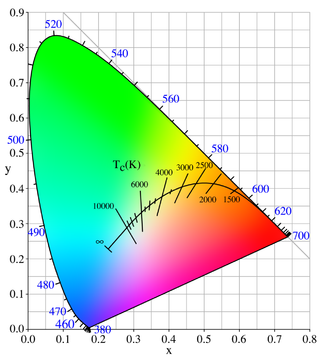
Color temperature is a parameter describing the color of a visible light source by comparing it to the color of light emitted by an idealized opaque, non-reflective body. The temperature of the ideal emitter that matches the color most closely is defined as the color temperature of the original visible light source. Color temperature is usually measured in kelvins. The color temperature scale describes only the color of light emitted by a light source, which may actually be at a different temperature.

In colorimetry, metamerism is a perceived matching of colors with different (nonmatching) spectral power distributions. Colors that match this way are called metamers.

The International Commission on Illumination is the international authority on light, illumination, colour, and colour spaces. It was established in 1913 as a successor to the Commission Internationale de Photométrie, which was founded in 1900, and is today based in Vienna, Austria.

The CIELAB color space, also referred to as L*a*b*, is a color space defined by the International Commission on Illumination in 1976. It expresses color as three values: L* for perceptual lightness and a* and b* for the four unique colors of human vision: red, green, blue and yellow. CIELAB was intended as a perceptually uniform space, where a given numerical change corresponds to a similar perceived change in color. While the LAB space is not truly perceptually uniform, it nevertheless is useful in industry for detecting small differences in color.
Colorimetry is "the science and technology used to quantify and describe physically the human color perception". It is similar to spectrophotometry, but is distinguished by its interest in reducing spectra to the physical correlates of color perception, most often the CIE 1931 XYZ color space tristimulus values and related quantities.
Chromatic adaptation is the human visual system’s ability to adjust to changes in illumination in order to preserve the appearance of object colors. It is responsible for the stable appearance of object colors despite the wide variation of light which might be reflected from an object and observed by our eyes. A chromatic adaptation transform (CAT) function emulates this important aspect of color perception in color appearance models.
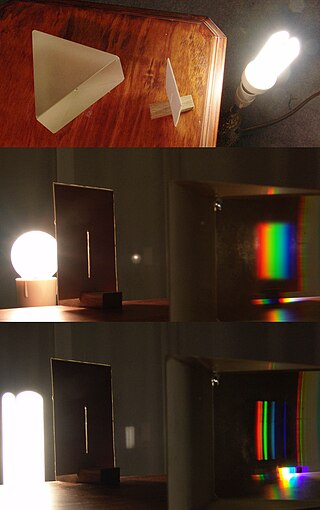
A color rendering index (CRI) is a quantitative measure of the ability of a light source to reveal the colors of various objects faithfully in comparison with a natural or standard light source. Light sources with a high CRI are desirable in color-critical applications such as neonatal care and art restoration.

In physics and color science, the Planckian locus or black body locus is the path or locus that the color of an incandescent black body would take in a particular chromaticity space as the blackbody temperature changes. It goes from deep red at low temperatures through orange, yellowish, white, and finally bluish white at very high temperatures.
A white point is a set of tristimulus values or chromaticity coordinates that serve to define the color "white" in image capture, encoding, or reproduction. Depending on the application, different definitions of white are needed to give acceptable results. For example, photographs taken indoors may be lit by incandescent lights, which are relatively orange compared to daylight. Defining "white" as daylight will give unacceptable results when attempting to color-correct a photograph taken with incandescent lighting.
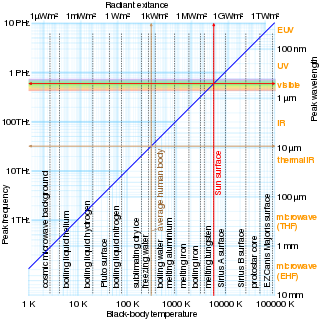
The correlated color temperature is defined as "the temperature of the Planckian radiator whose perceived color most closely resembles that of a given stimulus at the same brightness and under specified viewing conditions."

The CIE 1931 color spaces are the first defined quantitative links between distributions of wavelengths in the electromagnetic visible spectrum, and physiologically perceived colors in human color vision. The mathematical relationships that define these color spaces are essential tools for color management, important when dealing with color inks, illuminated displays, and recording devices such as digital cameras. The system was designed in 1931 by the "Commission Internationale de l'éclairage", known in English as the International Commission on Illumination.

A standard illuminant is a theoretical source of visible light with a spectral power distribution that is published. Standard illuminants provide a basis for comparing images or colors recorded under different lighting.

A gray card is a middle gray reference, typically used together with a reflective light meter, as a way to produce consistent image exposure and/or color in video production, film and photography.

The ColorChecker Color Rendition Chart is a color calibration target consisting of a cardboard-framed arrangement of 24 squares of painted samples. The ColorChecker was introduced in a 1976 paper by McCamy, Marcus, and Davidson in the Journal of Applied Photographic Engineering. The chart’s color patches have spectral reflectances intended to mimic those of natural objects such as human skin, foliage, and flowers, to have consistent color appearance under a variety of lighting conditions, especially as detected by typical color photographic film, and to be stable over time.
Color quality scale (CQS) is a color rendering score – a quantitative measure of the ability of a light source to reproduce colors of illuminated objects. Developed by researchers at NIST the metric aims to overcome some of the issues inherent in the widely used color rendering index.
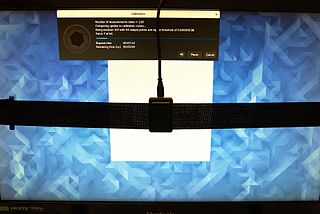
A tristimulus colorimeter, colloquially shortened to colorimeter, is used in digital imaging to profile and calibrate output devices. It takes a limited number of wideband spectral energy readings along the visible spectrum by using filtered photodetectors; e.g. silicon photodiodes.
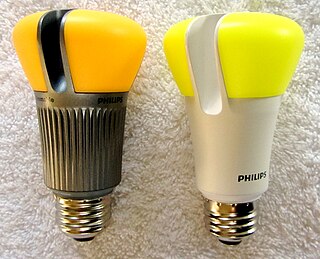
High-CRI LED lighting is a light-emitting diode (LED) lighting source that offers a high color rendering index (CRI).
The Academy Color Encoding System (ACES) is a color image encoding system created under the auspices of the Academy of Motion Picture Arts and Sciences. ACES is characterised by a color accurate workflow, with "seamless interchange of high quality motion picture images regardless of source".
A color appearance model (CAM) is a mathematical model that seeks to describe the perceptual aspects of human color vision, i.e. viewing conditions under which the appearance of a color does not tally with the corresponding physical measurement of the stimulus source.

In home cinema and video editing technology, bias lighting is a weak light source on the backside of a screen or monitor that illuminates the wall or surface behind and just around the display.
References
- ↑ "Neonatal intensive care unit lighting: Update and Recommendations".
- ↑ "CIE 17.4-1987 International Lighting Vocabulary". Archived from the original on 2010-02-27. Retrieved 2008-02-19.
- 1 2 "Television Lighting Consistency Index 2012". tech.ebu.ch. 31 May 2016.
- 1 2 "Spectral Similarity Index (SSI)". Oscars.org | Academy of Motion Picture Arts and Sciences. 21 April 2017.
- ↑ Michael Royer (March 31, 2016). "Evaluating Color Rendering With TM-30" (PDF). ENERGY STAR Webinar (US DOE).
- ↑ P. J. Bouma (1948). Physical aspects of colour; an introduction to the scientific study of colour stimuli and colour sensations. (Eindhoven: Philips Gloeilampenfabrieken (Philips Industries) Technical and Scientific Literature Dept.).
- ↑ American approach is expounded in Nickerson (1960), and the European approach in Barnes (1957), and Crawford (1959). See Schanda & Sándor (2003) for a historical overview.
- ↑ Rea, M.; Deng, L.; Wolsey, R. (2004). "Light Sources and Color". NLPIP Lighting Answers. Troy, NY: Rensselaer Polytechnic Institute. Archived from the original on 2010-06-11. Retrieved 2010-06-17.
- ↑ Sproson, W. N. & Taylor, E. W. (1971). A colour television illumination consistency index. BBC Research Department Report 1971-45
- ↑ European Broadcasting Union. "[Tech 3355] Method for the Assessment of the colorimetric properties of luminaires: The Television Lighting Consistency Index (TLCI-2012) &Television Luminaire Matching Factor (TLMF-2013)" (PDF). Retrieved 16 November 2021.
- 1 2 Academy of Motion Picture Arts and Sciences (2020-09-16). "Academy Spectral Similarity Index (SSI): Overview" (PDF).
- 1 2 Royer, Michael P. (16 March 2021). "Tutorial: Background and Guidance for Using the ANSI/IES TM-30 Method for Evaluating Light Source Color Rendition". LEUKOS. 18 (2): 191–231. doi:10.1080/15502724.2020.1860771. S2CID 233697915.
- ↑ "Using TM-30 to Improve Your Lighting Design – Illuminating Engineering Society".
- ↑ CIE (1999), Colour rendering (TC 1–33 closing remarks), Publication 135/2, Vienna: CIE Central Bureau, ISBN 3-900734-97-6, archived from the original on 2008-09-22, retrieved 2008-07-16
- ↑ Davis, W.; Ohno, Y. (2005). Ferguson, Ian T.; Carrano, John C.; Taguchi, Tsunemasa; Ashdown, Ian E. (eds.). "Toward an improved color rendering metric". Proc. SPIE. Fifth International Conference on Solid State Lighting. 5941: 59411G–1. Bibcode:2005SPIE.5941..283D. CiteSeerX 10.1.1.470.2414 . doi:10.1117/12.615388. S2CID 121431482.
- ↑ "Color Rendering" (PDF). Recommendations for Specifying Color Properties of Light Sources for Retail Merchandising. Vol. 8, no. 2. Alliance for Solid-State Illumination Systems and Technologies. March 2010. p. 6. Retrieved 2020-09-14.
Works cited
- Barnes, Bentley T. (December 1957). "Band Systems for Appraisal of Color Rendition". JOSA . 47 (12): 1124–1129. Bibcode:1957JOSA...47.1124B. doi:10.1364/JOSA.47.001124.
- Crawford, Brian Hewson (December 1959). "Measurement of color rendering tolerances". JOSA . 49 (12): 1147–1156. Bibcode:1959JOSA...49.1147C. doi:10.1364/JOSA.49.001147.
- Nickerson, Dorothy (January 1960). "Light sources and color rendering". JOSA . 50 (1): 57–69. Bibcode:1960JOSA...50...57N. doi:10.1364/JOSA.50.000057.
- Schanda, János; Sándor, Norbert (2003). Colour rendering, past – present – future. International Lighting and Colour Conference, Cape Town, South Africa, Nov 2–5, 2003. pp. 76–85.